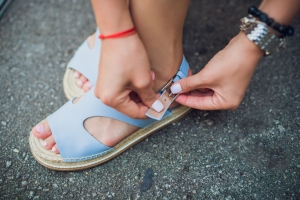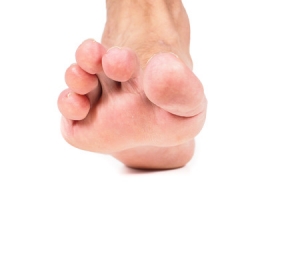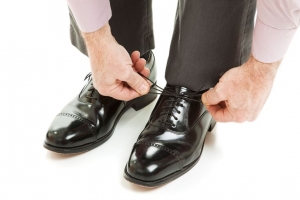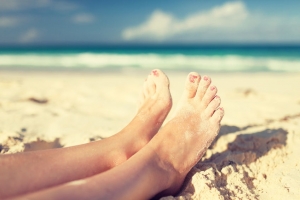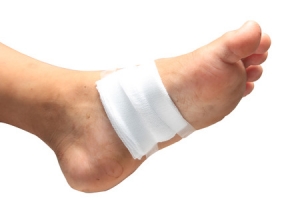Connect With Us
Blogs
Displaying items by tag: shoes
Summer Shoe Do’s and Don’ts
At Superior Foot & Ankle Care Center we know that many of our Los Angeles County patients welcome the summer season and the shoe wardrobe that accompanies it. While it’s always fun to wear fashionable footwear that suits the season our podiatrists, Dr. Victoria M. Foley and Dr. Constance Ornelas, always have the health and safety of your feet as a top priority. Below are some do’s and don’ts to consider when making summer shoe choices:
Do: contact our Long Beach office at (562) 420-9800 to schedule an appointment with our podiatrists if you have a chronic foot condition and require specific shoe style recommendations.
Do: make sure all your summer shoes fit properly. Discard shoes that hurt your feet whenever you wear them. Get your feet professionally measured when buying new summer shoes.
Do: use flip flops around the town pool, at the beach and other public places where there are lots of bare feet. This will help prevent common fungal infections like athlete’s foot and toenail fungus. Don’t use these shoes as your daily summer footwear choice, however, unless you buy upgraded versions that feature arch support and more structure to prevent injuries.
Don’t: forget to apply sunscreen to your feet when wearing sandals and other open styles that expose the skin on your feet.
Do: consider wedge-style heels over spikes for greater stability and reduced risk of ankle sprains.
Do: alternate the heel heights on the shoes you wear to prevent repetitive strain on your Achilles tendon and calf muscles. Avoid heels that are over two inches.
Don’t: wear flats for heavy walking days. While they may feel comfortable initially, the lack of an arch will ultimately lead to heel pain and discomfort.
Don’t: wear flip-flops for beach volleyball or sandals for hiking. Always choose the right shoe for the activity you are doing.
Do: wear socks with your sneakers to prevent blisters and absorb sweat. Change your socks as soon as you notice they feel damp. Fungal infections thrive in moist, dark places.
Do: keep moleskin with you to apply to any spot on your foot that feels like it might be forming a blister.
Fall Shoes Bring Bunion and Hammertoe Discomfort
At Superior Foot & Ankle Care Center, we often find that more women are making appointments at our Long Beach office in Douglas Park, CA the fall with complaints about their bunions and hammertoes. These are both deformities of the toes that can seem more painful than ever when patients switch from the open shoe styles of summer to closed toe shoes in the fall.
A bunion occurs when the big toe joint begins to move out of place and the big toe drifts toward the second toe. As the dislocation of the joint progresses, the telltale bump forms on the side of the toe. In the case of hammertoe, the second, third, or fourth toe begins to bend at the middle joint creating the hammer-like position of the toe and hence the name. Although these two conditions are different in appearance, they are both toe deformities and have several things in common.
The Shoe Factor
Bunions and hammertoes are both biomechanical problems that can be caused by an inherited tendency for the deformity, or a number of other risk factors, such as arthritis or a previous injury. Both conditions, however, can be made worse by wearing shoes that are too tight and narrow in the toe box. High-heeled shoes and boots can also exacerbate these conditions because they force feet forward and exert extra pressure on the toes.
What to Do
If you are experiencing increased discomfort from either a hammertoe or a bunion, make an appointment with our podiatrists, Dr. Victoria M. Foley or Dr. Constance Ornelas, so they can evaluate your toes and see how far the condition has progressed. The foot doctor will determine if surgery is needed to correct the problem or if you can get by at this point with conservative measures. These may include:
- Icing the toe
- Anti-inflammatory medications
- Shoe modifications or a custom orthotic
- Stretching exercises or physical therapy
Don’t wait. If you are in pain, contact us today and let us help you get relief.
Fall Sports Do’s and Don’ts
At Superior Foot & Ankle Care Center, we find that patients may not accurately understand the seriousness of decreased circulation to the lower extremities. The medical condition known as peripheral arterial disease (PAD) describes a situation where plaque (fatty deposits or cholesterol) have adhered to the walls of the arteries that lead to your legs and feet causing a partial or total blockage. This restricts the blood flow to the lower half of your body. PAD is often associated with diabetes and a significant cause of some of the more serious complications of the disease. When oxygen and nutrient-rich blood cannot get to your legs and feet in significant quantities, it makes it difficult to heal wounds and ulcers. This can lead to infection and, in extreme cases, amputation.
Recognize the Symptoms
There is a variety of symptoms of PAD that you may observe or experience. These include:
- Pain or cramping in your feet, legs, thighs or buttocks
- Feeling of coldness in your legs
- Hair loss on your toes and legs
- Bluish or reddish tinge to the skin on your feet or under the toenails
- Thickening and discoloration of your toenails
- Ulcers or wounds on your feet that have not healed after 8-12 weeks
If you notice any of these signs, you should contact our Long Beach office for an appointment by calling: (562) 420-9800. Our podiatrists, Dr. Victoria M. Foley or Dr. Constance Ornelas will want to examine your feet. There are a number of simple, non-invasive tests the foot doctor can perform to see if your symptoms point to PAD.
Reducing Your Risk
In addition to diabetes, PAD is also more common in patients who have high blood pressure, high cholesterol, heart disease or who have suffered a stroke. You are also at a higher risk for developing PAD if you are over the age of 50 or have a family history of PAD, heart disease or stroke. The good news, however, is that some risk factors for PAD are within your control to control. These include:
- Smoking
- Sedentary lifestyle
- Obesity
Making healthy lifestyle choices now and partnering with your podiatrist to monitor your foot health can help you prevent PAD or slow its progression. If you have additional questions about PAD, contact us at our Long Beach office in Douglas Park CA.
Shoe Tips You Should Know
At Superior Foot & Ankle Care Center, our podiatrists, Dr. Victoria M. Foley or Dr. Constance Ornelas know that your shoes play a significant role in the health of your feet. Many common podiatric disorders can be caused or made significantly worse by wearing improper footwear. That’s why our podiatrists may ask you to bring the shoes you wear most often to our Long Beach office when you come for your appointment. If you have a chronic foot problem, talk to the foot doctor (contact us at 562-420-9800) about the best styles and brands of shoes for your particular condition. Below are some recommendations for choosing good shoes.
- Start by getting your foot measured by a professional. Some studies estimate that as many as 9 out of 10 people are wearing shoes that are too small for them. Foot size can change as you age.
- You should not be surprised if one of your feet measures larger than the other. This is true for most people. Always buy shoes that fit the bigger foot.
- Shop for shoes at the end of the day—that’s when your foot is at its largest and most swollen.
- Choose shoes with good arch support. This will help prevent heel pain and plantar fasciitis. Wearing shoes that are completely flat like flip-flops or ballet slippers greatly increases your risk of this condition.
- Cushioned and molded footbeds not only feel more comfortable, they act as shock absorbers, reducing the impact of your foot hitting the ground with each step you take.
- Wear the type of sock you will most likely use with the shoes you are buying. If the podiatrist has prescribed a custom orthotic, you also try it on with the shoes.
- Always try on both shoes and spend some time walking around the store to check for comfort and fit.
- Don’t buy shoes that pinch your feet or feel tight anywhere. There is no such thing as a “breaking in” period. Shoes should feel comfortable from the moment you leave the store.
5 Ways to Take Care of Your Feet When Traveling
Do you have plans to take a vacation this summer? At Superior Foot & Ankle Care Center, we have seen too many patients happily making travel plans only to return a week later with a foot injury or other podiatric problem. Fortunately, many of these issues can be avoided if you take a few simple precautions. Below are five tips for ensuring safe travels for your feet and ankles.
- Take breaks. If your destination is more than an hour or two away, be sure to get up and walk around a bit and stretch periodically. In a plane or train, this is easy enough to do. If you are driving, plan to stop every couple of hours and get out of the car for a short walk.
- Wear compression stockings for long flights. These can prevent deep vein thrombosis and blood clots from forming in your legs by stimulating circulation and keeping the blood flowing to and from your extremities.
- Choose good travel shoes. Save the strappy sandals and flip-flops for your vacation site. Wear comfortable, supportive shoes traveling to and from your destination. Hauling luggage, running for flights and packing/unpacking requires good shoes.
- Check your children’s shoes before you go. Kids grow out of their shoes quickly. You don’t want your first “souvenir” shopping trip to be for new shoes for your child because the ones she has on your trip are too small and hurting her feet.
- Don’t forget to pack the foot care basics. Nail clippers, an emery board, moleskin, bandages, and antibiotic ointment can save the day when it comes to minor foot injuries and preventive care.
If you sustain a foot injury or experience acute pain in your toes, feet, or ankles while you’re away, seek medical attention promptly. Be sure to follow up with an appointment at our Long Beach office (562- 420-9800) when you return so that one of our podiatrists, Dr. Victoria M. Foley or Dr. Constance Ornelas can check your feet and make sure no further treatment is necessary.
How to Have Healthy Feet
January is a good time for starting new habits, and we at Superior Foot & Ankle Care Center would like to urge patients to make this the year that you commit to better care of your feet. We believe in educating our patients to be proactive about the health of their feet. There are many ways that you can reduce your risk of injury and foot disorders and improve your podiatric health. Below are some suggestions:
- Wash your feet every day with mild soap and warm water. Dry them thoroughly, with particular attention to the area between the toes. This will significantly reduce the risk of athlete’s foot.
- Don’t walk barefoot. Out in public, walking without shoes increase your risk of coming in contact with a fungal infection. Even at home, you can protect your feet from stepping on sharp objects by keeping them covered.
- Get in the habit of inspecting your feet on a regular basis. The best outcomes for foot disorders occur when they are treated in their earliest stages. Being vigilant about reporting changes in skin or nail color, swelling, bumps or growths, bruising and cuts that don’t seem to be healing to our podiatrists, Victoria Foley or Dr. Constance Ornelas, can save you from prolonged and invasive treatments.
- Making wise shoe choices. Did you know that the single most significant step you can take to improve the health of your feet is choosing good shoes? Styles with roomy toe boxes that don’t constrict your toes, adequate arch support and laces for a firm fit can reduce the risk of falls, joint conditions, and toe deformities. In addition, getting away from wearing high heels can prevent neuromas and lessen the chances of bunions and several other podiatric problems.
- Apply sunscreen, not just on beach days but any days when the bare skin of your feet will be exposed in open sandals or shoes to the sun. The skin on your feet is just as susceptible to skin cancer as the skin on the rest of your body.
- Take care of toenails. Keep your nails trimmed straight across and not too short to prevent ingrown toenails from developing.
Better foot care needn’t be complicated or time-consuming. A few simple changes in your daily regimen can make a world of difference. If you have questions regarding the care of your feet, contact our Long Beach office today by calling: (562) 420-9800.
Resolve to Get in Shape—Safely
Is starting a new fitness plan one of your New Year’s resolutions? At Superior Foot & Ankle Care Center we applaud this initiative, but also add a word of caution. We see too many patients who fail to take the necessary steps to ensure that their new fitness plan is safe. Prevent injuries and get your healthy resolution off to a smart start by taking into consideration the following.
Your Current Condition—do you suffer from any chronic foot or ankle disorders such as flat feet, plantar fasciitis or hammertoes? Our podiatrists, Dr. Victoria Foley or Dr. Constance Ornelas, can help you determine the best type of exercise and footwear to accommodate an existing podiatric condition. In some cases, special padding or even a custom orthotic device may be prescribed to make exercise more comfortable.
Long-term Goals—in order to determine the type of exercise to do, you need to know what your goals are. Do you want to lose weight? Have more strength and endurance? Improve flexibility and balance? Your general physician and exercise professionals can help match your goals to fitness activities and sports that will best achieve them.
Gear—in our opinion, your footwear is the most important piece of equipment for a new fitness program. Be sure that you get the right shoes for your sport and that they fit properly. If the foot doctor has recommended an orthotic, be sure it fits in your sports shoes. Look for socks that are not too bulky and ones that wick moisture away from your skin to prevent athlete’s foot and fungal infections.
Now you’re ready to begin. Start slow and gradually increase the degree of difficulty of your work out. If your feet or ankles hurt from your new exercise plan, contact our Long Beach office for an appointment by calling: (562) 420-9800.
Diabetic Foot Ulcers Can be Prevented
Did you know that the leading cause of lower extremity amputations not caused by trauma is diabetes? And, foot ulcers precede 85 percent of these amputations. At Superior Foot & Ankle Care Center we want patients to know that diabetic foot ulcers can be prevented and our podiatrists, Dr. Victoria Foley and Dr. Constance Omelas will work with you to develop a care regimen and monitor your feet as a diabetic patient. Adhering to a schedule of regular podiatric checkups is an important step in protecting your feet if you have diabetes. Below are other areas where you can be proactive in preventing ulcers:
Healthy Foot Habits—in addition to regular podiatric exams, doing your own self-exams at home is also very important. Foot ulcers commonly form on the soles of the feet so be sure you check the bottom of your feet carefully (or have someone do it for you) and the rest of your feet as well on a daily basis. Report any redness, sores, blisters, rashes or cuts to the foot doctor asap. You should also wash your feet daily and dry completely. Use foot powder and change your socks whenever you notice that your feet feel damp. This will reduce the risk of bacterial and fungal conditions which can lead to infections and wounds.
Footwear—the shoes you wear can play a big part in preventing conditions that can lead to wounds. Choose styles that are made of soft, flexible material and have wide, roomy toe boxes. Shoes that squeeze toes together can increase the risk of ingrown toenails and blisters and hasten the progression of toe problems like hammertoes and bunions. Periodically run your hand around the inside of your shoes to make sure there are no small pebbles stuck inside or loose stitching that can rub against the skin and cause an irritation.
Lifestyle Choices—one of the most important steps you can take for preventing ulcers is keeping your blood sugar levels where they should be. Follow the dietary plan your doctor has given you and fill your menus with nutrient-rich foods that are low in sugar. Don’t smoke because it impedes circulation. Limit alcohol use as this has been linked with an increased risk of foot ulcers.
If you have diabetes and have additional questions about how to best care for your feet and prevent diabetic complications, contact our Long Beach office by calling: (562) 420-9800.
